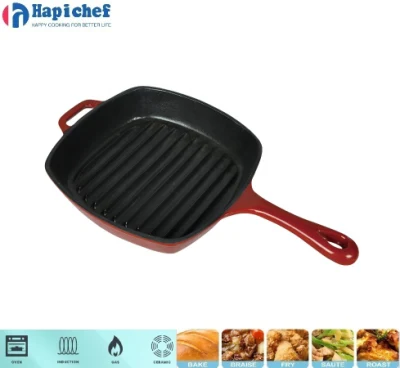storing cast iron pans supplier
Storing Cast Iron Pans Tips from a Supplier Perspective
Cast iron pans are a beloved kitchen staple for many cooking enthusiasts, thanks to their superior heat retention and versatility. However, proper storage is essential to maintaining their quality and longevity. As a supplier of cast iron cookware, we understand that how these pans are stored can significantly affect their performance and durability. Here are some expert tips on how to effectively store your cast iron pans.
1. Clean and Dry Thoroughly
Before storing your cast iron pans, it’s essential to clean them properly. Use warm water and a stiff brush to scrub away food remnants. Avoid using soap, as it can strip the seasoning from the pan. After washing, dry the pan thoroughly with a towel or by placing it on low heat for a few minutes. Ensuring that your pans are completely dry is crucial, as moisture can lead to rust.
2. Seasoning is Key
Regularly seasoning your cast iron pans can help protect them from moisture and create a non-stick surface. To season, apply a thin layer of vegetable oil or melted shortening on the surface of the pan and bake it upside down in a preheated oven at 375°F (190°C) for an hour. This process not only enhances the non-stick properties but also creates a protective barrier against rust.
3. Use a Lid or Cover
If you have a lid that fits your cast iron pan, it’s a good idea to use it during storage. A lid can help protect the surface from dust and scratches. If a lid is not available, consider using a breathable cloth or paper towel. This will help to keep the surface intact while allowing moisture to escape, preventing buildup.
storing cast iron pans supplier

4. Avoid Stacking
Stacking cast iron pans can lead to scratches and chipping. If you have multiple pans, try to find a dedicated space for each one. If space is limited and stacking is unavoidable, place a layer of cloth or cardboard between the pans to protect the surfaces.
5. Store in a Dry Place
Humidity is the enemy of cast iron cookware. When storing your pans, make sure to keep them in a dry location. Avoid damp areas such as under the sink or in a basement. If you live in a particularly humid climate, consider using silica gel packets in the storage area to absorb moisture.
6. Regular Maintenance
Regular maintenance is essential for keeping your cast iron pans in top condition. After each use, clean and dry them properly, and reapply oil if needed. This routine will help reinforce the seasoning and keep the pans ready for your next culinary adventure.
Conclusion
Storing cast iron pans correctly is vital for maintaining their quality and ensuring they last for generations. By following these tips, you can protect your investment and enjoy the many benefits of cast iron cooking. As a reliable supplier, we encourage all cast iron owners to prioritize proper storage and maintenance, as it will significantly enhance your culinary experiences. Happy cooking!
-
hapichefs-casserole-cast-iron-cookware-symphonyNewsAug.23,2025
-
casserole-cast-iron-cookware-in-a-modern-art-installationNewsAug.23,2025
-
hapichefs-molten-artistry-portable-cast-iron-bbq-grill-birthNewsAug.23,2025
-
forging-flavor-in-acast-iron-bbq-grills-fireNewsAug.23,2025
-
hapichefs-enameled-cast-iron-bakeware-a-chefs-museNewsAug.23,2025
-
why-colorful-enameled-cast-iron-bakeware-improves-meal-tasteNewsAug.23,2025
-
Unleash Your Culinary Creativity with Specialized Roasting and Baking PansNewsAug.20,2025
